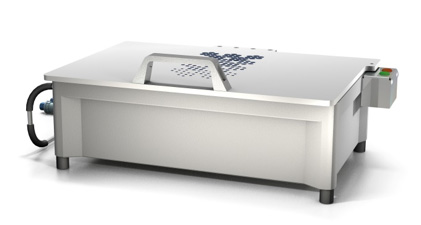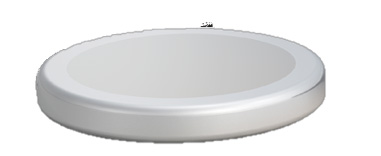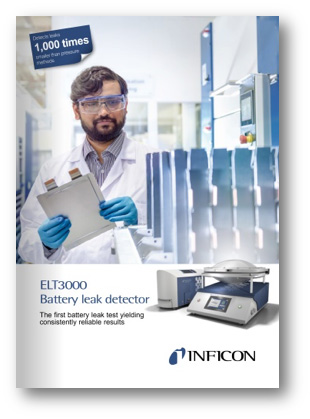NEW - ELT3000: Leak Test Specifically for Lithium-ion Battery Cells

ELT3000 leak detector for lithium-ion battery cells
INFICON has developed a new device for integrity testing of lithium-ion battery cells, such as those used in mobile devices or in drive batteries for EV, HEV and FCV vehicles. The new INFICON ELT3000 identifies leaks in all types of hard case cells like prismatic, round and coin cells. The new process from INFICON directly detects electrolyte solvent leaking from a battery cell. It is, therefore, far more reliable than conventional methods such as pressure measurement or helium bombing. The ELT3000 can test battery cells for leaks of a few micrometers in diameter, which corresponds to a helium equivalent leak rate of 1∙10-6 mbar∙l/s. This makes it sensitive enough to ensure a battery cell life of up to 10 years. INFICON has designed the device to be suitable for use at manual workstations in the development department, as well as for the simultaneous testing of several cells in automated production lines. The simple test sequence and its touch display make the ELT3000 intuitive to operate.
Direct leak testing by detection of electrolyte solvent

TC3000L rigid chamber for hardcase cells
The new ELT3000 device consists of two components: a gas detection system for electrolyte solvents and a control unit for the gas flows. A test chamber is also required - INFICON offers two different chamber sizes. After the battery is placed in the chamber, the test can be started at the push of a button. The control unit then generates a vacuum of a few mbar absolute in the chamber. Battery cells are usually filled with electrolyte at a pressure of several hundred mbar. The pressure difference causes electrolyte to escape from the cell through any leaks and the solvent content evaporates in the vacuum of the test chamber. This makes it detectable for the mass spectrometer of the gas detection system. The ELT3000 can directly detect all common electrolyte solvents such as DMC, DEC, EMC and PP. Depending on the volume of the chamber, cycle times between 30 and 60 seconds are possible.
More reliable than helium bombing, more sensitive than pressure measurement
Thanks to its mass spectrometer technology, the INFICON battery cell tester can detect leaks that are 1,000 times smaller than conventional pressure measurement methods - indispensable for a long cell life. In this specific application scenario, ELT3000 is also far more reliable than a method such as helium bombing. In bombing, the battery cell is first placed in a vacuum chamber and then exposed to a helium atmosphere under overpressure. In this way, the test gas helium is supposed to penetrate the cell through any leaks. The helium is then detected in a final step when it emerges again through the leak. However, the exact location of the leak and the position of the battery cell are crucial for the success of the bombing method. If the leak is located on the underside of the cell, for example, the final vacuum test cannot reliably detect the test gas because the light helium in the battery cell rises to the top and may not escape from the leak at the bottom at all.
Traceable results

E-Check test leak for ELT3000
The direct test method with the ELT3000 does not know the problems presented through helium bombing. The ELT3000 identifies leaks by directly detecting leaking electrolyte solvent. At the same time, it minimizes human error sources during testing and ensures traceable results.
The device stores all test data for export and can be reliably calibrated using the INFICON E-Check test leaks, fulfilling the requirements of the ISO9000 standard. The detection system compares the result of each test with a previously defined trigger value and immediately indicates any leaks. It is also very easy to assign test results to the specific test object. To do this, a barcode scanner is connected to the standardized interface of the ELT3000, which can be used to record each cell individually. The system then links the exact test results with the respective part ID and a time stamp.

Product availability
The ELT3000 for hard case cells is available immediately.
Future outlook
An additional setup of the ELT3000 for testing soft pouch cells will be available towards the end of 2020.
Further information can be found in our brochure and on our website. For detailed questions, please contact your nearest sales representative.
